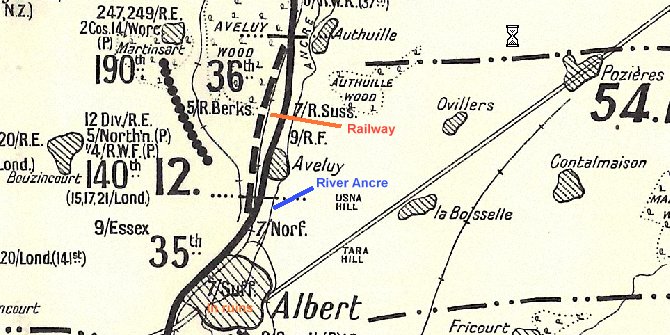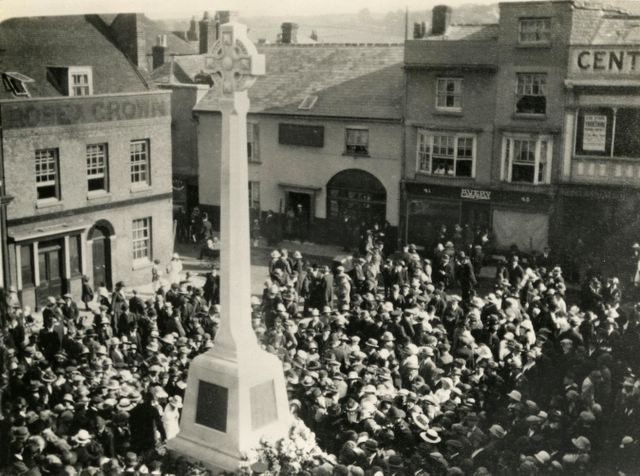Second Lieutenant Frank Masterton
9th Royal Fusiliers
died 5th April 1918
aged 38
Bouzincourt Ridge Cemetery, Albert
Borough War Memorial, Newport, Isle of Wight
Isle of Wight War Memorial, Carisbrooke Castle
Son of Charles William Masterton and Emily Jones
Husband of Lizzie Lowe
Isle of Wight, England
aged 38
Bouzincourt Ridge Cemetery, Albert
Borough War Memorial, Newport, Isle of Wight
Isle of Wight War Memorial, Carisbrooke Castle
Son of Charles William Masterton and Emily Jones
Husband of Lizzie Lowe
Isle of Wight, England
Genealogy
Frank Masterton was born in Southwark, London, England in the first three months of 1880, the fourth of nine children and the third son born to Charles William Masterton, variously a confectioner & tobacconist, picture frame maker and painter, and Emily Jones who had married in 1874 in Camberwell, London. Frank married Lizzie Lowe before September 1915 in the Isle of Wight, England.
Further details of Frank, his parents and eight siblings and the extended family of Mastertons that flourished in the London area can be found at the following link.
His War
Frank Masterton was serving at Dover on the outbreak of war in 1914 as an Instructor and Company Sergeant Major in the Royal Fusiliers, No L/6465, and in 1916 he was drafted to France, and on 18th January 1918 gazetted Second Lieutenant.
At the time of his death he was serving in the 9th Battalion, Royal Fusiliers (City of London Regiment). Both the 8th and the 9th were raised on 21 August 1914 at Hounslow as part of K1 and came under command of 36th Brigade, 12th (Eastern) Division. It landed in France in May 1915.
Soon after midday on 26th March 1918, five days into the German Spring Offensive, their last attempt to win the war before the Americans arrived in force, Germans were seen advancing down the slopes into the Ancre valley. They were also seen in large numbers to the south of Albert moving on Meaulte and Dernancourt and by 7pm Albert itself was full of them. The 7/Suffolks had to withdraw through the ruined town to west of the railway line. On the northern side too, it seemed that the Division was in great danger of being outflanked, for enemy had got to Grandcourt and Beaumont Hamel. All units came under increasing pressure as the enemy pressed on. Many enemy attacks were repelled with heavy casualties, although the Division suffered 1634 casualties in halting their advance.
The 12th (Eastern) Division was finally relieved by 47th (London) Division on 29 March and moved to Warloy. After a short rest, the Division came back to the front line on 2 April. Further enemy efforts on 5 and 6 April were beaten off, yet by the time relief came from 38th (Welsh) Division and the 12th Division had withdrawn to Toutencourt, another 1285 men were lost, amongst them Second Lieutenant Frank Masterton.

Frank was killed on 5th April fighting off the German Spring Offensive.
Sir Arthur Conan Doyle was to say in his "British Campaign in France and Flanders, January to July 1918" of the Division's role in March and April that they "withdrew from the line in glory, for it is no exaggeration to say that they had fought the Germans to an absolute standstill". He was right. The enemy offensive in Picardy had finally been defeated.
Frank was buried in Bouzincourt Ridge Cemetery, Albert. He is also commemorated on the Borough War Memorial, Newport, Isle of Wight and on the Isle of Wight memorial in St Nicholas in Castro Chapel, Carisbrooke Castle.

Frank's name is on Great War Panel 2 of the Borough War Memorial, Newport, Isle of Wight
War Diary 9th Battalion, Royal Fusiliers.
In the Line: 5th April 1918:
7 A.M. At 7 am heavy hostile shelling on our left which had spread by 7.30 am to our own front and to our right. Very heavy on BOUZINCOURT. Shelling continued heavy until 9 am. At 9.5 am the
S.O.S. was sent up on our right, and at 9.20 am "C" Coy and "B" Coy reported that Enemy were coming over the ridge in front. S.O.S sent up by "C" Coy and repeated at Bri H.Q. by Rocket and lamp.
M.G.s and Artillery put down a good barrage and our L. Gunners and riflemen opened fire. Attack did not develop. Shelling continued heavy at 10 am but died down on our part of the front towards 11 am.
At 11.45 am report was received from "A" Coy that enemy had penetrated the line of the 5th R. BERKS on the right. The C.O. at once sent forward three platoons of "D" Coy to counter-attack this portion of the line over the open. They came under heavy M.G. fire, but gained their objective and worked down the trench for a distance of 300 yards beyond our original right flank where a hostile bombing block was met, strongly held by the enemy. At 1.45 pm one Coy 7th R. SUSSEX arrived to support us and took over the Res. Line vacated by 3 platoons of "D" Coy. Remaining platoon of "D" Coy sent forward to thicken our front line.
2-4 pm: From 2 pm - 4 pm shelling of BOUZINCOURT continued to be heavy. "D" Coy still unable to get touch with the 5 R. BERKS on their right.
10 pm: At 10 pm 2 Coys of 7th R. SUSSEX attached 5th R. BERKS counter-attacked to re-establish the line between ourselves and the BERKS. Owing to heavy M.G. fire, they failed to gain their objective. At 11 pm the 7th R. SUSSEX relieved the BERKS and took over from us with one Coy. the 300 yards of their trench which we had recaptured.
Our casualties during the day's fighting:
2/Lieut. F. MASTERTON Killed
" W. PARR DUDLEY "
" A. H. TOZER Wounded
" E.H.J. SKINNER "
" C. BAUGH "
" C. HOWE "
" R.T. EAGAR Wounded (at duty)
Total casualties to O.R.s 93.
National Archives
Kew, London
WO 95/1857/2
9 Battalion Royal Fusiliers
June 1915 - June 1919
National Roll of the Great War
MASTERTON, F., Lieut., 9th Royal Fusiliers: He was serving at Dover on the outbreak of war as an Instructor and in 1916 was drafted to France, where he was gazetted to a commission. He fought at Arras, and in numerous other engagements until April 1918, when he was unfortunately killed in action at Albert. He was entitled to the General Service and Victory Medals.
Other Sources
- Frank Masterton Medal Index Register
- Frank Masterton Medal Roll Index Card
- Frank Masterton's Deceased Soldier's Effects
- Commonwealth War Graves Commission
- The 12th (Eastern) Division. The Long Long Trail. Accessed 23 Sep 2019.
- Frank Masterton in IWM Lives of First World War
- Medals: Victory, British War